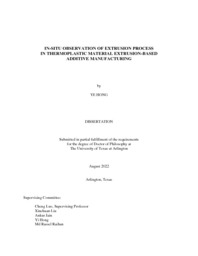
ATTENTION: The works hosted here are being migrated to a new repository that will consolidate resources, improve discoverability, and better show UTA's research impact on the global community. We will update authors as the migration progresses. Please see MavMatrix for more information.
Show simple item record
| dc.contributor.advisor | Luo, Cheng | |
| dc.creator | Hong, Ye | |
| dc.date.accessioned | 2023-06-30T15:54:24Z | |
| dc.date.available | 2023-06-30T15:54:24Z | |
| dc.date.created | 2022-08 | |
| dc.date.issued | 2022-08-15 | |
| dc.date.submitted | August 2022 | |
| dc.identifier.uri | http://hdl.handle.net/10106/31449 | |
| dc.description.abstract | In thermoplastic material extrusion-based additive manufacturing, solid polymer filaments are fed into extruders to generate extrudates that are needed to build 3D plastic products. There is a finite gap between the inner surface of an extruder and the edge of a filament. This gap facilitates the insertion and translation of the filament inside the extruder. However, it is still not clear how the gap is filled during the extrusion. The lack of this information makes it difficult to model the temperature distribution and flow profile during the extrusion. In this work, we built experimental apparatus to directly observe the gap-filling processes of Acrylonitrile Butadiene Styrene (ABS) and Polylactic Acid (PLA) filaments, for different combinations of extrusion temperatures and feed rates. Although ABS and PLA are, respectively, amorphous and semi-crystalline polymers, for both materials, we found: i) the gap inside an extruder was filled through three different steps during the initial stage of extrusion; ii) the gap-filling level depended on extrusion temperature and feed rate; and iii) there was no noticeable difference in the gap-filling level when the extrusion started with an empty tube or resumed after the printing had been paused. The steady extrusion processes of ABS were simulated with computational fluid dynamic software. Two sets of simulations were conducted: one with a glass tube and the other with an aluminum tube. The numerical results for the case of the glass tube were validated by comparing them with experimental results. The simulation results indicated: 1) when polymer flow was sufficiently heated, the flow characteristics were similar in the cases of glass and aluminum tubes; 2) if the feed rates were high, due to shorting heating time and low thermal diffusivity of the polymeric material, the polymer were insufficiently heated and clogging might occur; and 3) as the heat transferred faster through the aluminum tube to the polymer, the feed rate that caused clogging in the case of the aluminum tube was higher than its counterpart in the case of the glass tube. | |
| dc.format.mimetype | application/pdf | |
| dc.language.iso | en_US | |
| dc.subject | Material extrusion | |
| dc.subject | In-situ observation | |
| dc.subject | Extrusion process | |
| dc.subject | Gap-filling process | |
| dc.subject | Feed rate | |
| dc.subject | Extrusion temperature | |
| dc.subject | Numerical simulation | |
| dc.title | In-situ Observation of Extrusion Process in Thermoplastic Material Extrusion Based Additive Manufacturing | |
| dc.type | Thesis | |
| dc.date.updated | 2023-06-30T15:54:25Z | |
| thesis.degree.department | Mechanical and Aerospace Engineering | |
| thesis.degree.grantor | The University of Texas at Arlington | |
| thesis.degree.level | Doctoral | |
| thesis.degree.name | Doctor of Philosophy in Mechanical Engineering | |
| dc.type.material | text | |
| dc.creator.orcid | 0000-0002-8544-8044 | |
| local.embargo.terms | 2023-08-01 | |
| local.embargo.lift | 2023-08-01 | |
Files in this item
- Name:
- HONG-DISSERTATION-2022.pdf
- Size:
- 2.727Mb
- Format:
- PDF
- Name:
- Video 12 Fig. 18b.mp4
- Size:
- 1.769Mb
- Format:
- Unknown
- Name:
- Video 11 Fig. 18a.mp4
- Size:
- 3.449Mb
- Format:
- Unknown
- Name:
- Video 10 Fig. 17b.mp4
- Size:
- 1.211Mb
- Format:
- Unknown
- Name:
- Video 9 Fig. 17a.mp4
- Size:
- 2.501Mb
- Format:
- Unknown
- Name:
- Video 8 Fig. 16b.mp4
- Size:
- 3.258Mb
- Format:
- Unknown
- Name:
- Video 7 Fig. 16a.mp4
- Size:
- 5.017Mb
- Format:
- Unknown
- Name:
- Video 6 Fig. 14b.mp4
- Size:
- 2.403Mb
- Format:
- Unknown
- Name:
- Video 5 Fig. 14a.mp4
- Size:
- 1.372Mb
- Format:
- Unknown
- Name:
- Video 4 Fig. 13b.mp4
- Size:
- 2.169Mb
- Format:
- Unknown
- Name:
- Video 3 Fig. 13a.mp4
- Size:
- 1.743Mb
- Format:
- Unknown
- Name:
- Video 2 Fig. 12b.mp4
- Size:
- 3.939Mb
- Format:
- Unknown
- Name:
- Video 1 Fig.12a.mp4
- Size:
- 3.982Mb
- Format:
- Unknown
This item appears in the following Collection(s)
Show simple item record


